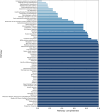Genomic insights into Streptomyces albidoflavus SM254: tracing the putative signs of anti-Pseudogymnoascus destructans properties
- PMID: 40694258
- PMCID: PMC12350921
- DOI: 10.1007/s42770-025-01740-8
Genomic insights into Streptomyces albidoflavus SM254: tracing the putative signs of anti-Pseudogymnoascus destructans properties
Abstract
White-nose syndrome, caused by the psychrophilic fungus Pseudogymnoascus destructans, has devastated bat populations across North America. Streptomyces albidoflavus SM254 was previously reported to exhibit antifungal activity against this pathogen, but no comprehensive genomic characterization has been performed to date. Here, we analyzed 34 S. albidoflavus genomes, including the antifungal strain SM254 and 33 publicly available references, to investigate its metabolic potential and functional distinctiveness. Using pangenome reconstruction, phylogenomics, average nucleotide identity, and KEGG pathway profiling, we found that S. albidoflavus SM254 shares high nucleotide identity (> 99%) with five closely related strains but displays a unique combination of complete ethanol fermentation capacity and asparagine biosynthesis deficiency. These traits were exclusive to SM254 and may reflect adaptation to the oxygen-limited, nutrient-variable sediment environment. Functional annotation further revealed high completeness in central energy, redox, and stress-response pathways. Although direct antifungal mechanisms remain to be experimentally validated, S. albidoflavus SM254's unique metabolic profile and ecological specialization suggest potential relevance in biocontrol contexts.
Keywords: Pseudogymnoascus destructans; Streptomyces albidoflavus SM254; Comparative genomics; White-nose syndrome.
© 2025. The Author(s).
Conflict of interest statement
Declarations. Institutional review board statement: Not applicable. Conflict of interest: The authors declare no competing interests.
Figures






Similar articles
-
Genomic insights into biosynthesis and adaptation in the bioactive marine bacterium Streptomyces albidoflavus VIP-1 from the Red Sea.BMC Microbiol. 2025 Jun 26;25(1):372. doi: 10.1186/s12866-025-04109-x. BMC Microbiol. 2025. PMID: 40571923 Free PMC article.
-
Prescription of Controlled Substances: Benefits and Risks.2025 Jul 6. In: StatPearls [Internet]. Treasure Island (FL): StatPearls Publishing; 2025 Jan–. 2025 Jul 6. In: StatPearls [Internet]. Treasure Island (FL): StatPearls Publishing; 2025 Jan–. PMID: 30726003 Free Books & Documents.
-
Drugs for preventing postoperative nausea and vomiting in adults after general anaesthesia: a network meta-analysis.Cochrane Database Syst Rev. 2020 Oct 19;10(10):CD012859. doi: 10.1002/14651858.CD012859.pub2. Cochrane Database Syst Rev. 2020. PMID: 33075160 Free PMC article.
-
Genomic and phenotypic insights into Serratia interaction with plants from an ecological perspective.Braz J Microbiol. 2025 Jun;56(2):1219-1239. doi: 10.1007/s42770-025-01652-7. Epub 2025 Mar 25. Braz J Microbiol. 2025. PMID: 40131635
-
Inhaled magnesium sulfate in the treatment of acute asthma.Cochrane Database Syst Rev. 2017 Nov 28;11(11):CD003898. doi: 10.1002/14651858.CD003898.pub6. Cochrane Database Syst Rev. 2017. PMID: 29182799 Free PMC article.
References
-
- Lorch JM, Meteyer CU, Behr MJ et al (2011) Experimental infection of bats with geomyces destructans causes white-nose syndrome. Nature 480:376–378. 10.1038/nature10590 - PubMed
-
- Lindner DL, Gargas A, Lorch JM et al (2011) DNA-based detection of the fungal pathogen geomyces destructans in soils from Bat hibernacula. Mycologia 103:241–246. 10.3852/10-262 - PubMed
-
- Garcês A, Pires I (2024) Pseudogymnoascus destructans as the agent of White-Nose syndrome (WNS) in Bat populations. Biology Life Sci Forum 31:20. 10.3390/ECM2023-16696
Grants and funding
LinkOut - more resources
Full Text Sources

